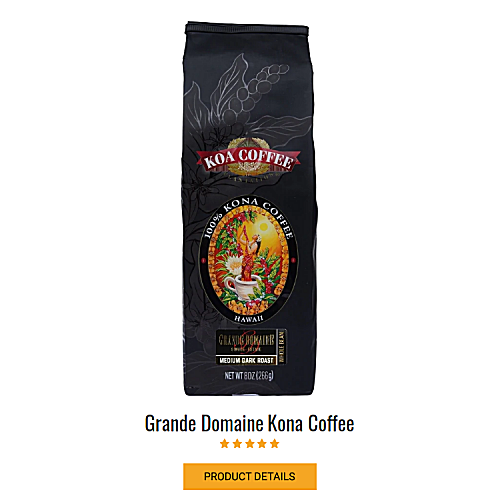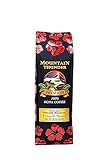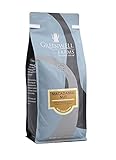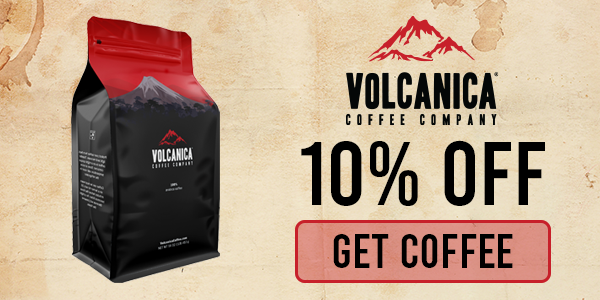In the global panorama of coffee culture, few names stir as much excitement and admiration as Kona Coffee. Yet many ask the question, “What is Kona Coffee?” This prized brew is not just another type of coffee; it is a testament to a unique geography, a dedicated community, and a meticulous process that all align to create an unparalleled coffee experience.
Kona beans come from the fertile volcanic slopes of Mauna Loa and Hualalai in the North and South Kona Districts of Hawaii’s Big Island. This extraordinary coffee variety stands out for its rich, full-bodied flavor and low acidity, much of which can be attributed to the unique growing conditions that exist only in this small part of the world.
In this article, we invite you to embark on a journey exploring the unique world of this delectable coffee, from the volcanic ground where it is grown to the flavorful cup that is enjoyed by coffee connoisseurs worldwide. We’ll delve into the history, cultivation, flavor profile, brewing process, and sustainable practices that surround this luxurious coffee, providing a comprehensive understanding of why Kona Coffee is not just a beverage, but a tradition, a livelihood, and a symbol of Hawaiian pride.
Kona Coffee: Key Takeaway
- Distinctive Origin: This beverage is unique due to its geographical origin in the Kona region of Hawaii, which contributes to its distinctive taste.
- Volcanic Influence: The volcanic soil of the Kona region enhances the flavor profile of this concoction, making it one of the most sought-after coffee varieties in the world.
- Brewing Mastery: The brewing method significantly impacts the taste of this drink, with techniques like drip coffee making, French press, and pour over each offering a different flavor experience.
- Sustainability Matters: The use of organic farming and fair trade practices in this coffee production ensures high-quality beans and supports the local economy.
- Variety is the Spice: The taste of this beverage varies between different varieties, each offering a unique flavor profile, thus catering to a wide range of coffee aficionados.
The History and Heritage of Kona Coffee
Delving into the history and heritage of this beverage takes us on an intriguing journey of cultural heritage, agricultural resilience, and economic triumph. The story of Kona beans is as rich and complex as its taste, and it’s a testament to the spirit of the Hawaiian people and the uniqueness of the land they call home.
The Origins of Kona Coffee
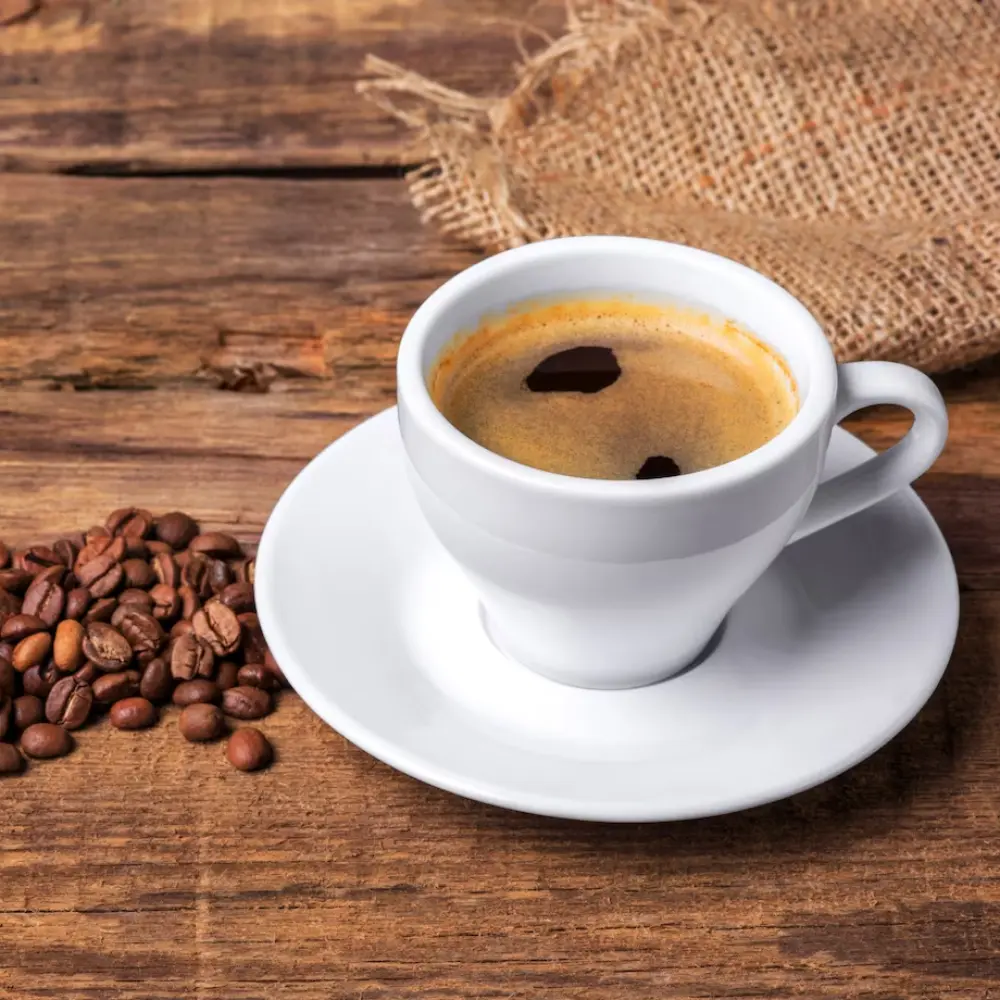
Kona coffee, often referred to as Hawaiian Kona coffee, has its origins in the early 19th century when coffee was first introduced to the Kona district by Samuel Reverend Ruggles. In 1828, he brought cuttings of Brazilian Arabica coffee and planted them in Kona’s fertile volcanic soil. The coffee plants thrived in the unique climate of the Kona mountain range, and by the mid-19th century, a thriving coffee industry had begun to take root in the region. (1)
The Development of the Kona Coffee Industry
The development of this coffee industry has been a journey of hard work, persistence, and adaptation. In the late 19th century, when the sugar industry collapsed, many farmers in the Kona region turned to coffee farming as their primary source of income. They established small, family-owned farms, many of which still operate today and can be visited on Kona coffee tours.
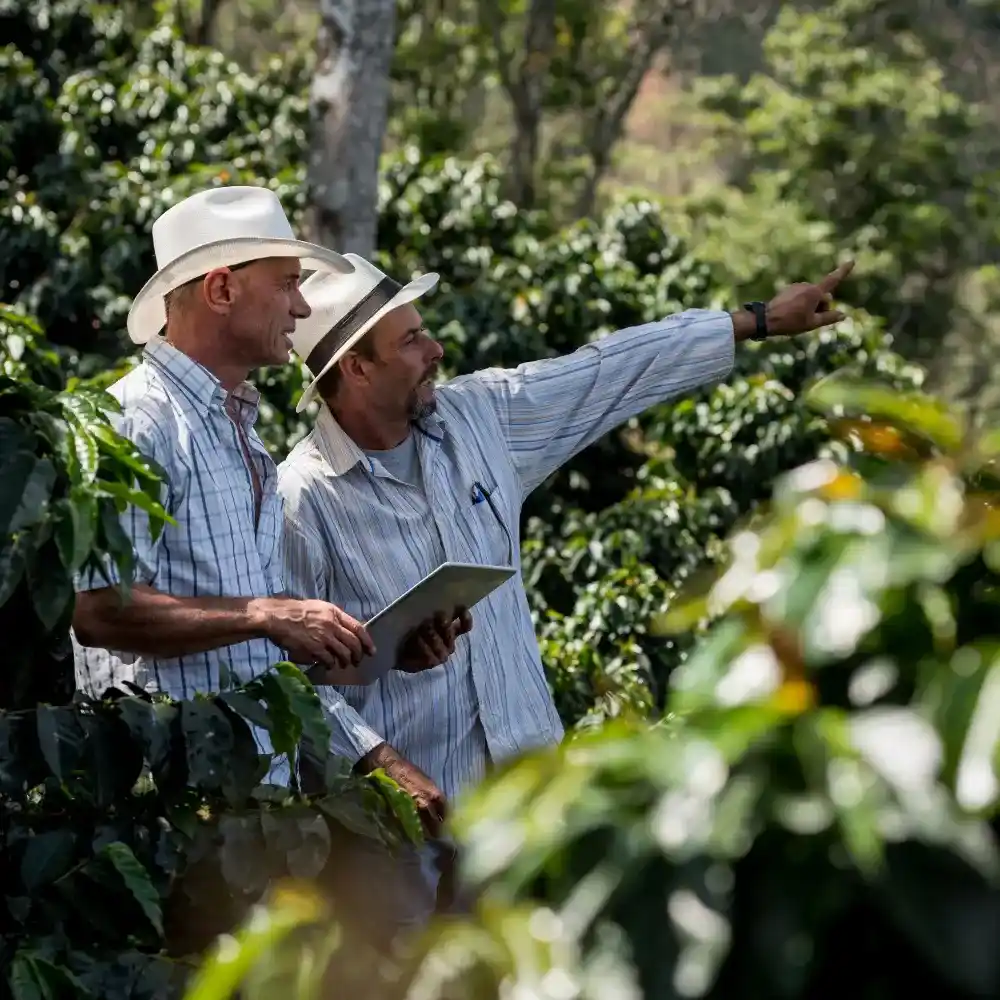
The Kona coffee farm model is unique. Unlike large-scale coffee plantations found in other parts of the world, Kona beans are grown on small farms, often less than 5 acres. The farms are situated on the slopes of Mauna Loa, and the coffee trees benefit from the region’s fertile volcanic soil and favorable weather conditions. Each farm takes great pride in the quality of its beans, and every step of the coffee production process, from picking to processing to packaging, is carefully managed to ensure the highest quality product.
Kona Coffee: A Global Sensation
Over the years, this delectable beverage has grown from a local specialty to a global sensation. Its distinct flavor profile, coupled with the fascinating story of its production, has captured the attention and palates of coffee enthusiasts worldwide. Today, Kona coffee beans are one of the most sought-after coffee varieties on the international market.

This drink’s global popularity has also boosted Hawaii’s economy. The annual Kona Coffee Cultural Festival, Kona coffee tours, and the growing demand for these coffee products have attracted tourists and coffee aficionados from around the world, contributing significantly to the region’s tourism and hospitality industries. Despite its global recognition, the production of genuine Kona beans remains exclusive to the Kona district, further enhancing its prestige and appeal.
The Unique Cultivation of Kona Coffee
The cultivation of this coffee is as unique as the coffee itself. The combination of volcanic soil, ideal climate, and meticulous harvesting process all contribute to the distinctive characteristics that make this beverage one of the world’s most sought-after brews.
The Volcanic Soil: The Secret Ingredient
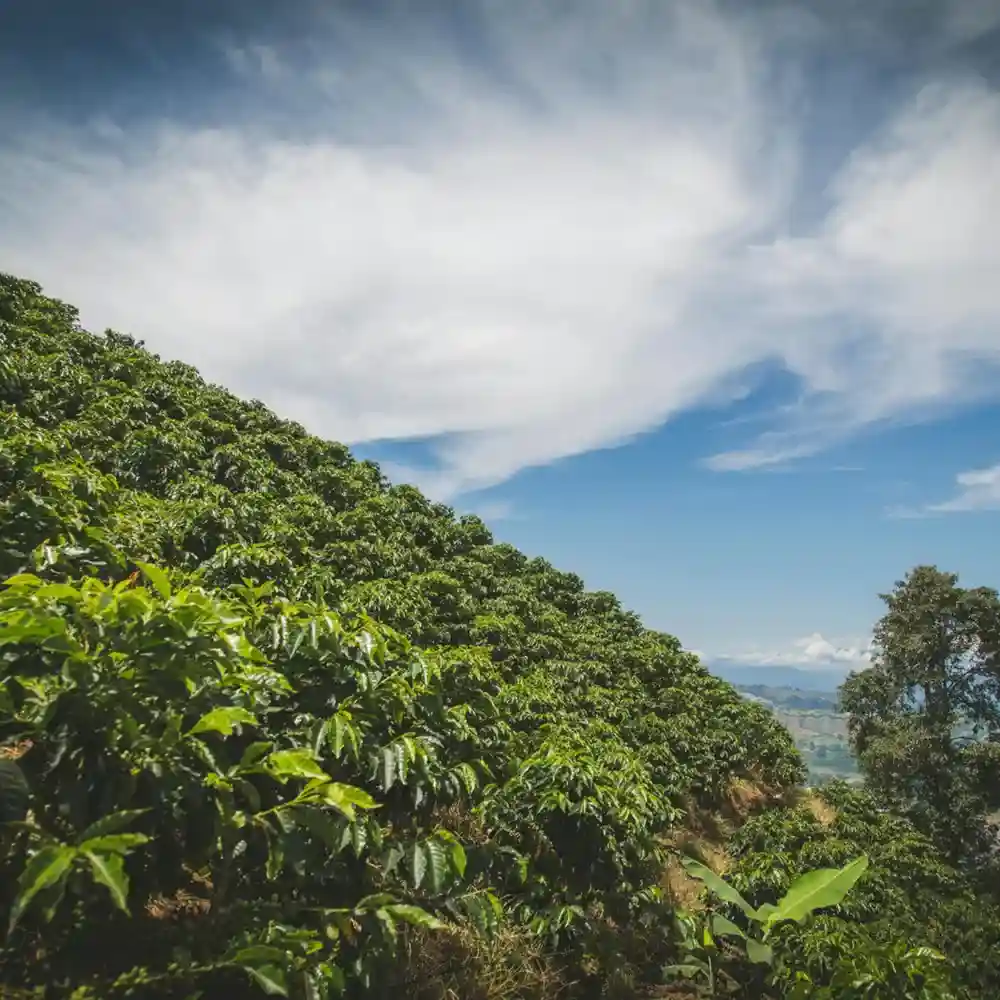
The secret ingredient that sets Hawaiian Kona coffee apart is the rich volcanic soil of Kona Mountain. The Kona coffee farmlands are nestled on the slopes of Mauna Loa, one of the world’s largest and most active volcanoes. The volcanic soil here is rich in minerals and naturally porous, allowing it to retain water and provide perfect drainage, creating an optimal growing environment for the coffee plants. This rich soil imparts a unique flavor profile to the coffee, resulting in a brew that is smooth, rich, and full-bodied.
The Climate: Perfect for Kona Coffee
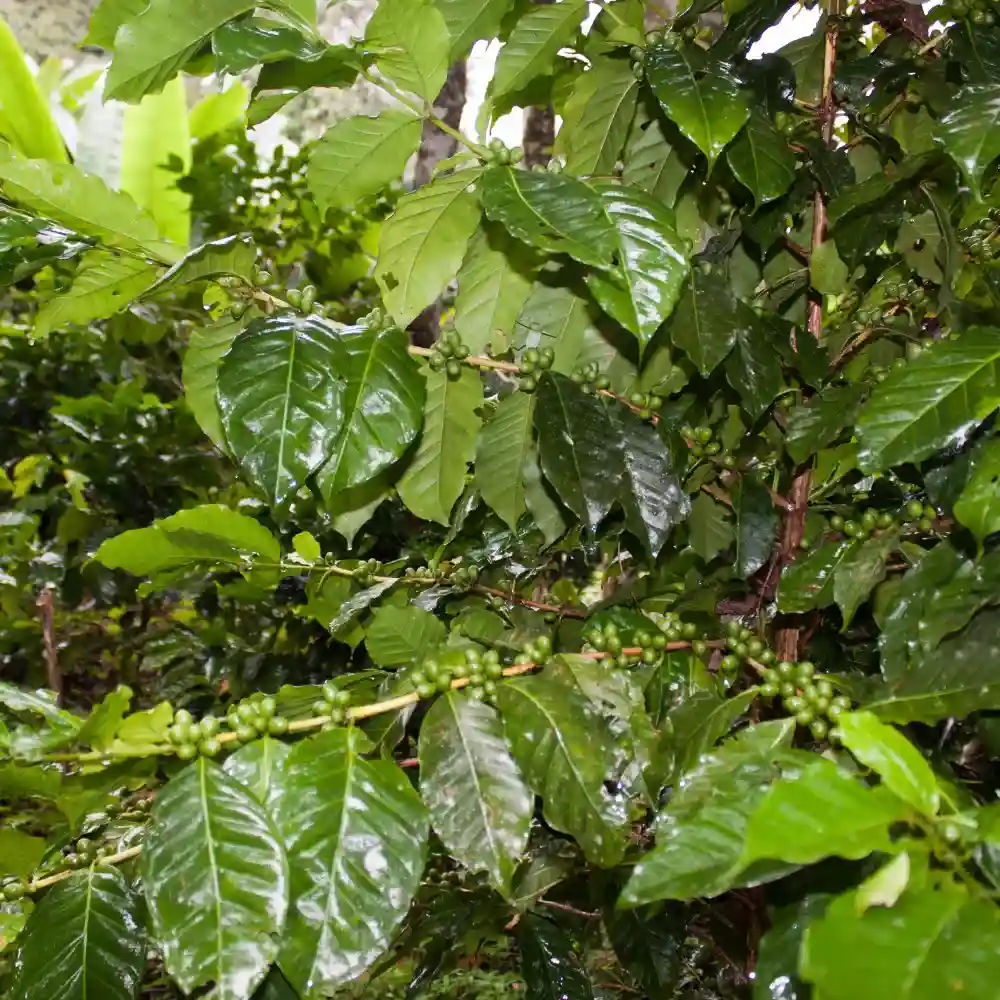
Equally important to the cultivation of Kona beans is the unique microclimate of the Kona region. The area’s tropical climate, characterized by sunny mornings, rainy afternoons, and mild nights, provides the perfect balance of sunlight, rainfall, and temperature that coffee plants need to thrive. Moreover, the Mauna Loa volcano shields the Kona district from the harsh trade winds, creating a calm and stable environment for the coffee trees. This ideal climatic condition ensures a slow maturation of the coffee cherries, leading to beans that are larger and have a higher sugar content, which translates into a sweeter, richer cup of coffee.
The Hand-Picked Harvesting Process
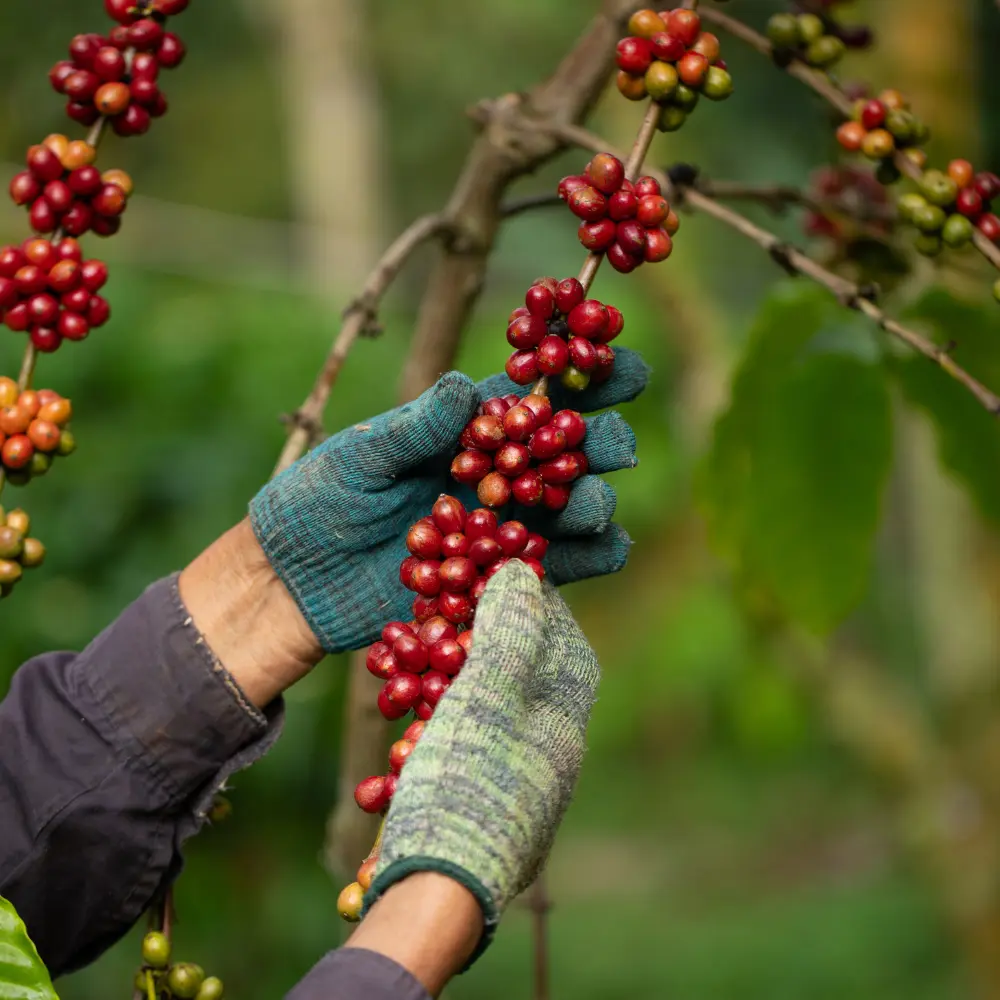
Another unique aspect of this coffee cultivation is the harvesting process. Unlike many other coffee-producing regions where mechanization is the norm, Kona coffee farms rely on hand-picking to harvest their coffee cherries. This labor-intensive method ensures that only the ripest cherries are picked at the optimal time, leaving the unripe cherries to mature on the tree. This selective harvesting plays a significant role in maintaining the high quality and consistency of this drink. Each hand-picked coffee cherry is a testament to the dedication and hard work of the farmers, and this commitment to quality shines through in every cup of joe.
The Process: From Kona Coffee Beans to Your Cup
The journey of Kona beans, from the volcanic slopes of the Kona mountains to your cup, is a fascinating tale of meticulous care and precision. Every step in this process, from processing the coffee cherries to roasting the beans, contributes to the rich, distinctive flavor of Hawaiian Kona coffee.
Processing: The Path to Purity

Once harvested, the coffee cherries undergo a rigorous processing phase. This coffee follows two primary processing methods – wet and dry. The wet process involves pulping the cherries to eliminate outer layers, followed by fermentation and washing to cleanse any remaining mucilage. The dry process, on the other hand, involves sun-drying the cherries with the outer layers intact, then hulling to remove these layers. Both processes play a vital role in preserving the unique flavor of the coffee beans.
Sorting and Grading of Kona Coffee Beans

An essential step in this coffee production process is the sorting and grading of beans. Following the harvesting and processing stages, the beans are sorted to remove any defective or low-quality ones, such as those damaged, discolored, or misshapen. This process is typically done by hand, with machines employed to eliminate any remaining defects.
After sorting, the beans are graded based on their size and shape. This beverage follows a scale from one to five, with grade one representing the highest quality. Following the grading process, the beans undergo cupping, a sensory evaluation process that assesses flavor, acidity, body, and aftertaste. This critical stage is handled by trained professionals familiar with the unique flavor profile of this drink.
The Transformation: Roasting Kona Coffee Beans
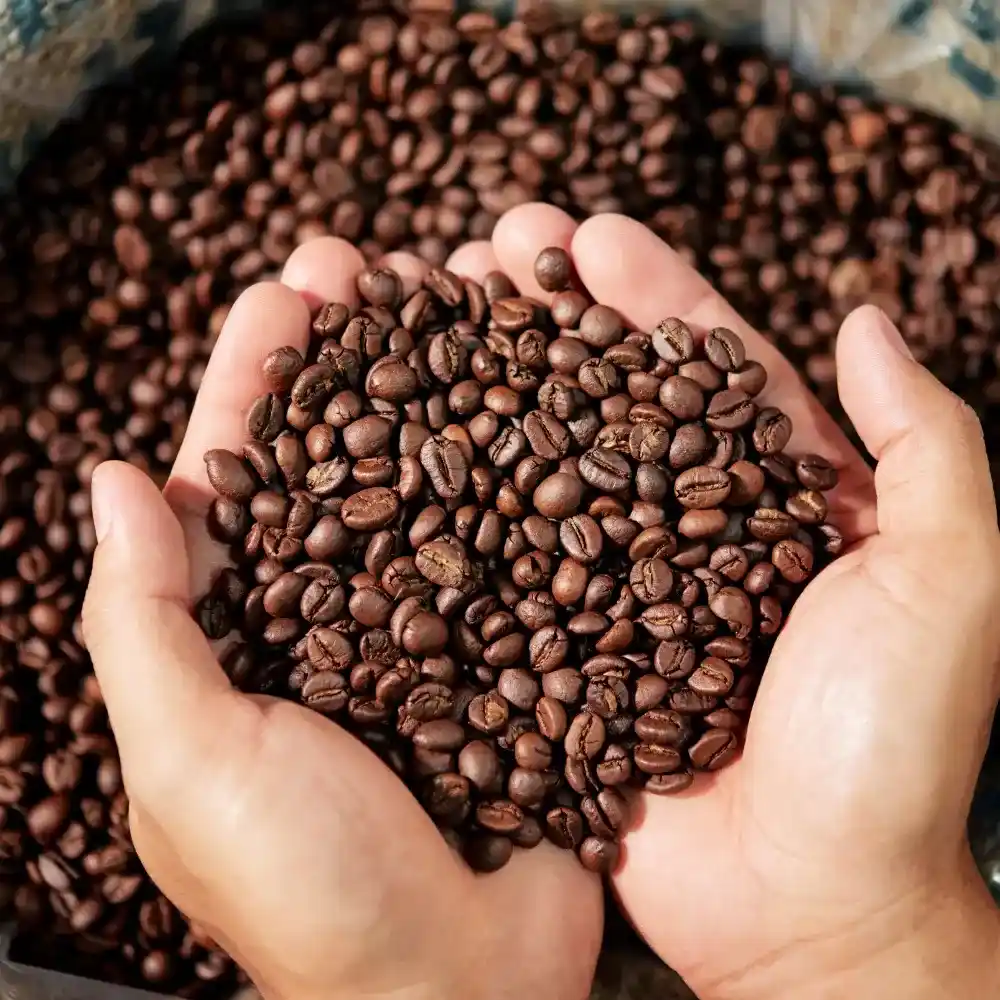
After processing, the beans are primed for roasting, a crucial stage that significantly influences the flavor profile of this coffee. The beans are typically roasted to a medium or medium-dark roast, unveiling the coffee’s distinctive flavor notes. Depending on the desired roast level, this process could take anywhere between 12 to 20 minutes.
Packaging and Distribution: From Kona to the World
The final step in the journey is the packaging and distribution of the roasted Kona beans. Each batch of this coffee is sold in small quantities, with labels indicating the specific Kona coffee farm where it was grown and processed, and the grade of the beans. This attention to detail not only highlights the premium quality of this beverage but also enhances the overall experience of those who embark on Kona coffee tours.

To sum up, the production of this coffee is a detailed, labor-intensive process. From sorting and grading to roasting and packaging, every stage is handled with the utmost care, contributing to the high-quality brew that has positioned this beverage as a favorite among coffee enthusiasts worldwide.
Decoding the Grades of Kona Coffee
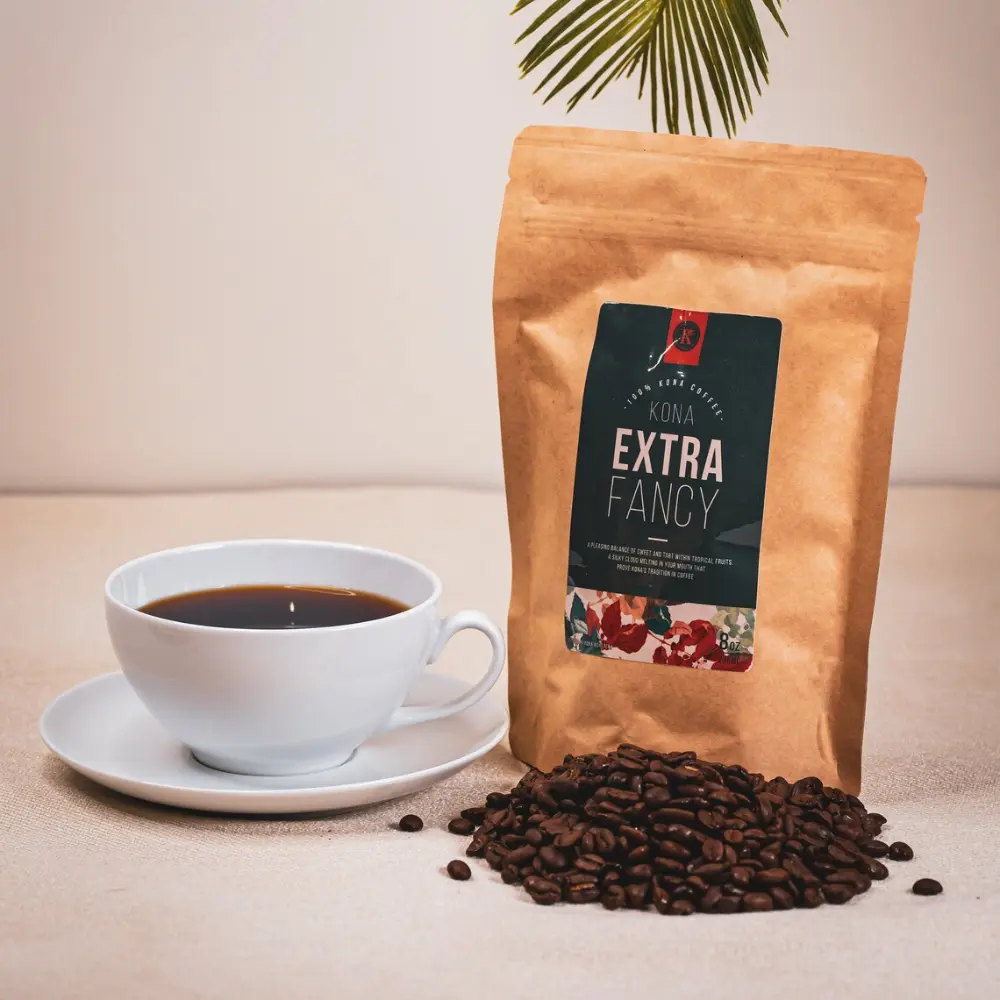
Understanding the intricacies of this delectable drink goes beyond appreciating its taste. The grading of Kona beans, which is based on their size, shape, and color, is a fascinating journey into the heart of what makes this coffee so unique. Let’s delve into the world of this beverage grading and understand what each grade brings to your cup of coffee.
Grade 1: Kona Extra Fancy
Also known as “Grade 1” Kona coffee, this is the zenith of this coffee grading. Comprising the largest, most perfect beans uniform in size and shape, these beans embody minimal defects and present a deep, rich color. The strong, well-rounded flavor sets the benchmark for the highest-quality coffee.
Grade 2: Kona Fancy
A notch below the Extra Fancy but still considered high-quality coffee, Grade 2 or “Kona Fancy” consists of slightly smaller beans. They may display minor defects or imperfections, but overall, they maintain uniformity in size and shape. The flavor is lighter and more mellow compared to the Grade 1 beans, yet it still produces a high-quality coffee.
Grade 3: Kona Number 1
This grade, also known as “Kona Number 1,” represents mid-range coffee. The beans are smaller than Fancy, with more defects and less uniformity in size and shape. With a lighter color and a less complex flavor, these beans are used to produce mid-range coffee.
Grade 4: Kona Select
Known as “Prime” or “Grade 4” Kona coffee, these beans are smaller, less uniform, and exhibit a greater number of defects and imperfections. Despite their lighter color and weaker flavor, they find use in lower-end coffee blends and instant coffee.
The Specialty: Kona Peaberry
A unique type of Kona coffee, Kona Peaberry, is made from beans that grow individually inside the coffee cherry instead of in pairs. These beans are smaller, rounder, and denser than regular Kona beans. They offer a slightly different flavor profile, with a brighter, more acidic taste and a lighter body. Kona Peaberry can be found in any of the above grades, depending on the size and shape of the individual beans.
It’s important to remember that while the grading system provides a general measure of the quality of this delectable beverage, it’s not a definitive predictor of the coffee’s taste. The grade focuses primarily on the beans’ appearance, but the final quality of the brew depends on factors like roasting and brewing techniques.
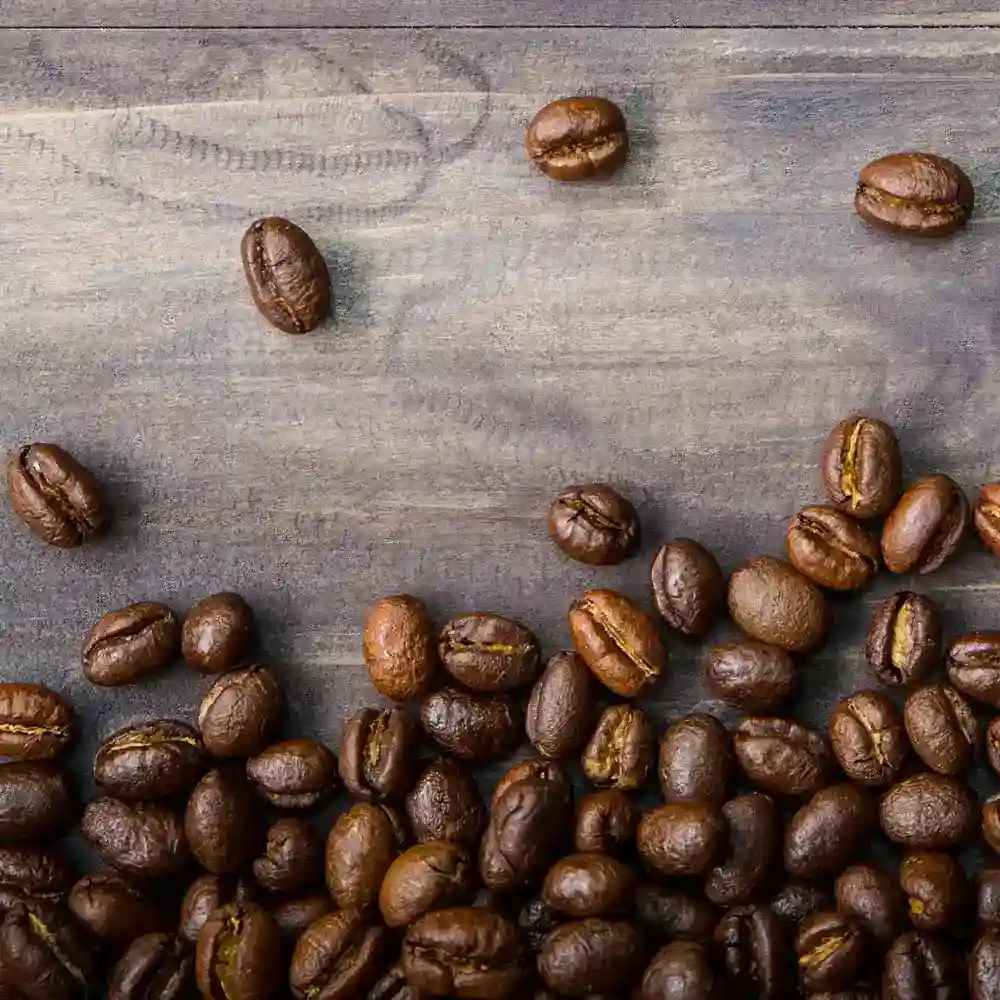
Moreover, the soil quality, growing conditions, and processing methods also play a significant role in the taste and character of the coffee. Therefore, the grading system serves as a valuable tool for evaluating bean quality and determining market value, helping coffee buyers and sellers negotiate prices and decide on beans for specific applications, such as high-end coffee blends or single-origin offerings.
Mastering the Art of Brewing Kona Coffee
This delightful drink, renowned for its unique flavor and aroma, can be brewed using several methods. Each technique extracts distinctive qualities from the beans, making the coffee experience truly versatile. Here are three popular methods to brew this coffee to perfection:
Traditional Drip Coffee Maker
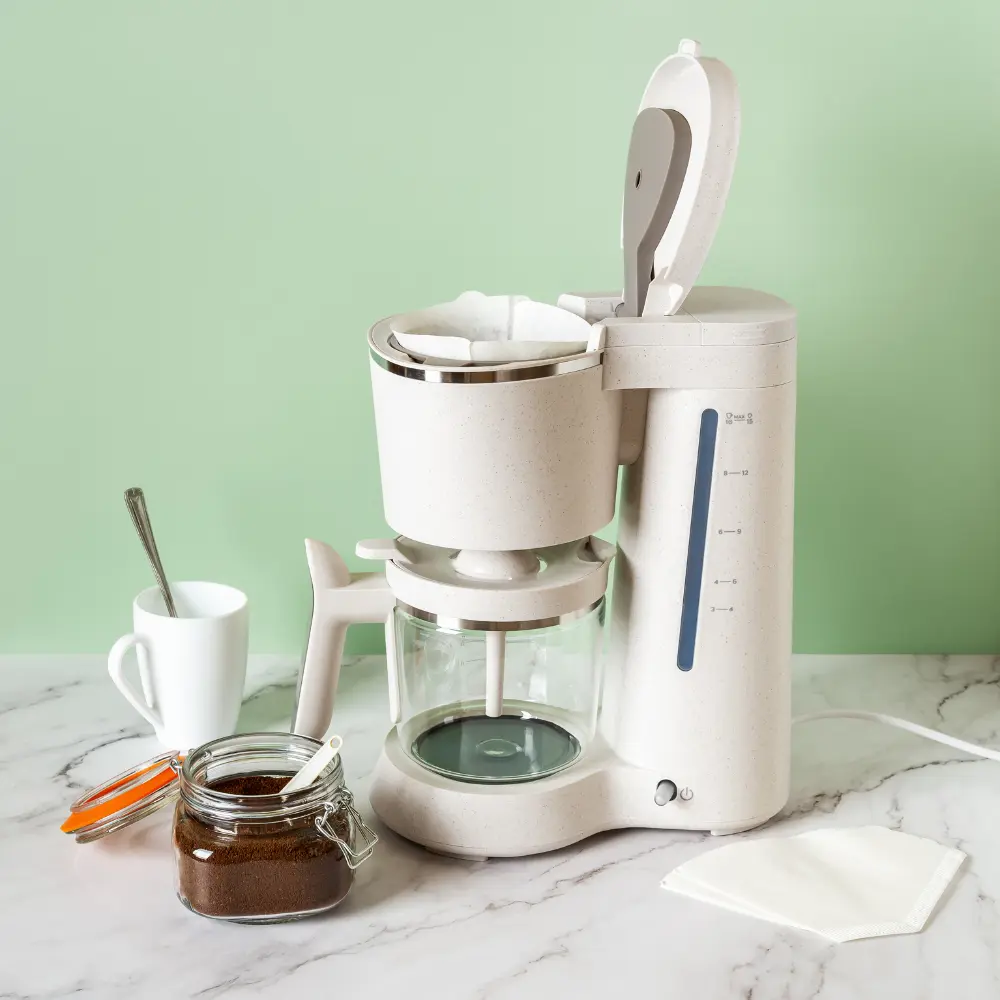
The drip coffee maker is a staple in many households and one of the most prevalent methods to brew this coffee. To capture the smooth and balanced taste of this drink using a drip coffee maker, follow these steps:
- Grind the Kona beans to a medium consistency.
- Place the ground coffee into the machine’s filter.
- Fill the water reservoir.
- Initiate the brewing process and let the machine work its magic.
This method yields a well-rounded cup of coffee, perfect for everyday enjoyment.
French Press Method
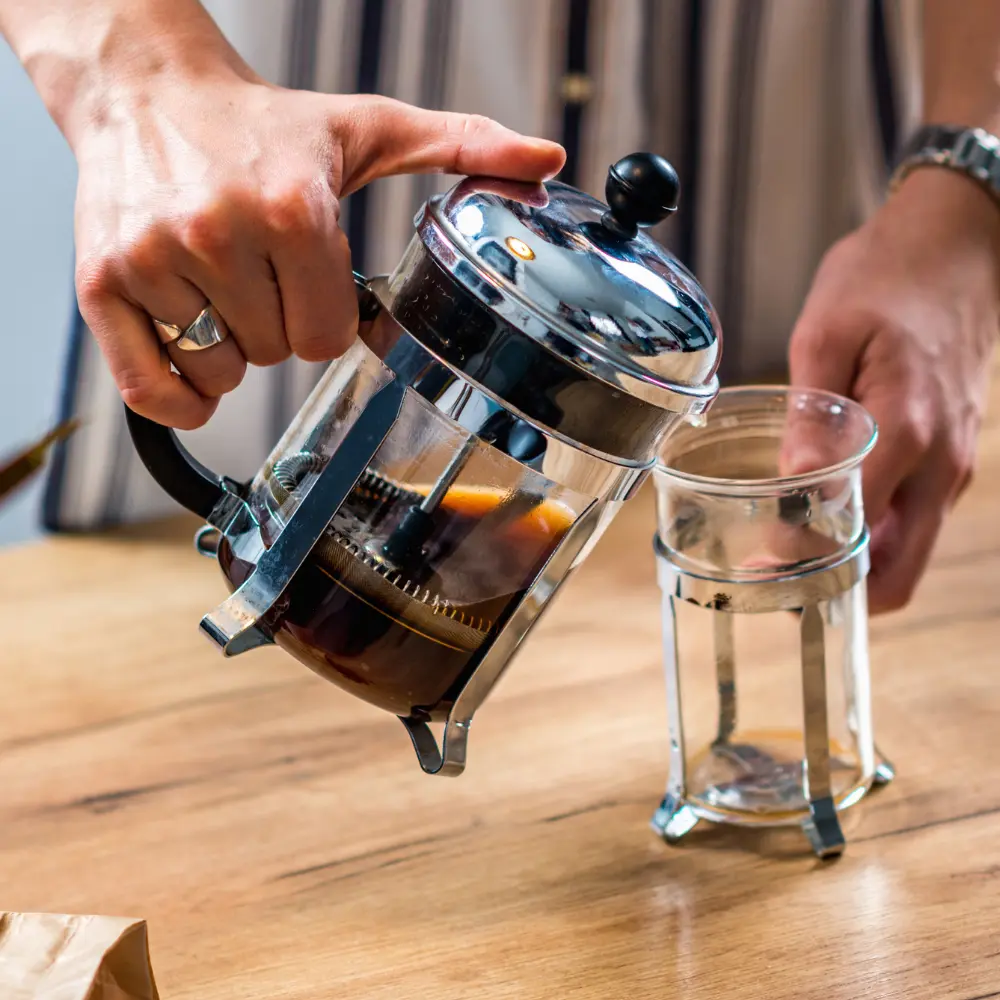
For those who prefer bold and full-bodied coffee, the French Press is an ideal brewing method. Here’s how to brew this coffee using a French press:
- Bring water to a boil.
- Grind your Kona beans to a coarse texture.
- Place the ground coffee into your French press.
- Pour in the boiling water.
- Allow the coffee to steep for about four minutes.
- Gradually press down the plunger to separate the coffee grounds from the liquid.
The result is a robust and flavorful cup of coffee that’s rich in aroma.
Pour-Over Technique

The pour-over method is a manual brewing technique that offers maximum control over the brewing process, extracting the purest flavors from your coffee. To use this method, follow these steps:
- Grind your Kona beans to a medium-fine texture.
- Place the ground coffee into a filter in a pour-over dripper.
- Position the dripper atop a coffee mug.
- Gradually pour hot water over the coffee grounds, ensuring even saturation.
- Allow the coffee to filter into the mug below.
This process results in a clean and vibrant cup of coffee, highlighting its unique flavor notes.
By experimenting with these popular brewing methods, coffee enthusiasts can discover the perfect brew that best complements their tastes and preferences.
Tips for Brewing the Perfect Cup of Kona Coffee
Brewing the perfect cup of Kona coffee requires attention to detail and a few key techniques. Here are three tips for brewing the perfect cup of coffee:
Grind the Coffee Beans Correctly

Grinding the coffee beans correctly is an essential part of brewing the perfect cup of this beverage. The grind size affects the flavor and aroma of the coffee, so it’s important to choose the right grind size based on the brewing method you plan to use. For a drip coffee maker, opt for a medium grind, while a French press benefits from a coarse grind. If you’re using the pour-over method, a medium-fine grind is the way to go for a perfectly balanced cup of coffee.
Use the Right Water Temperature
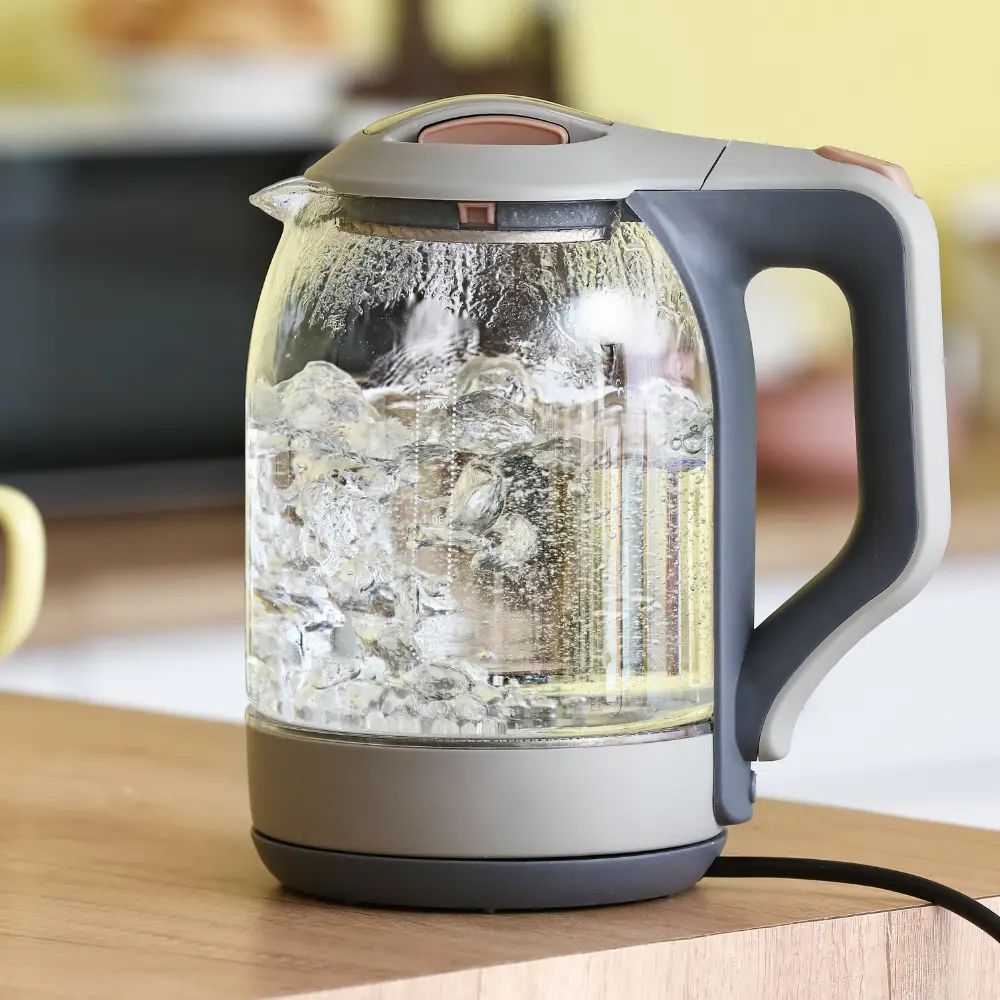
Using the right water temperature is also important for brewing the perfect cup of this drink. The water temperature should be between 195-205°F (90-96°C) to extract the maximum flavor from the coffee. If the water temperature is too low, the coffee will be weak and under-extracted. If the water temperature is too high, the coffee will be bitter and over-extracted.
Experiment with Ratios

Experimenting with ratios can also help you achieve the perfect cup of this coffee. The ideal coffee-to-water ratio is between 1:15 and 1:17, meaning that for every 1 gram of coffee, you should use 15-17 grams of water. However, this can be adjusted based on personal taste preferences. For a stronger cup of coffee, use a higher coffee-to-water ratio, and for a weaker cup of coffee, use a lower ratio.
By following these tips for brewing the perfect cup of Kona coffee, coffee lovers can enjoy a rich and flavorful cup of coffee that highlights the unique flavors and aromas of this lovely beverage.
Discovering the Best Kona Coffee Brands
Dive into the aromatic world of Kona coffee with these top-tier brands. Each of them brings a unique flavor profile that celebrates the distinctiveness of this coffee. Here are five authentic Kona coffee brands to consider for an extraordinary coffee experience.
Koa Coffee: A Commitment to Quality and Freshness

Koa Coffee is one of the most celebrated coffee brands, known for its attention to detail in the selection and roasting process. Their coffee beans are 100% Kona, hand-picked, and roasted in small batches to maintain maximum freshness. Forbes has acknowledged their commitment to excellence by naming them the “Best Coffee in America.”
Key Features:
- 100% Kona products
- The hand-picking process to ensure the selection of the best beans
- Small-batch roasting to maintain optimal freshness
- Numerous accolades for quality, including being named the “Best Coffee in America” by Forbes
Pros:
- Quality coffee with a unique flavor profile
- A strict selection process ensures only the best beans are used
- Freshness is preserved through small-batch roasting
- High recognition and accolades affirm the brand’s quality
Cons:
- Pricing may be higher than other coffee brands due to the quality and process involved
- Availability might be limited in certain regions
Guru’s Verdict: Koa Coffee is an outstanding choice for coffee enthusiasts looking for a superior coffee experience. Their dedication to quality, from bean selection to roasting, ensures a unique and flavorful cup of coffee. While the price may be higher compared to other brands, the award-winning quality justifies the cost. However, availability could be limited in some areas.
Mountain Thunder Coffee Plantation: Family-Owned Excellence

For over two decades, Mountain Thunder Coffee Plantation, a family-run business, has been producing exceptional coffee. Nestled on the slopes of the Hualalai volcano, the plantation’s coffee is 100% Kona. Sustainability is at the heart of their farming practices, reflecting their commitment to the highest quality coffee.
The Thunderous Appeal of Mountain Thunder
Mountain Thunder’s coffee beans are known for their high-quality, organic, and sustainably grown attributes. The beans are hand-picked and roasted on-site, offering a unique flavor that has garnered a dedicated following.
Key Features:
- Organic and sustainable farming practices
- Hand-picked and roasted on-site
- Educational tours and tastings are available
Pros:
- High-quality beans yielding unique flavors
- Eco-conscious farming practices
- Informative and engaging tours and tastings
- Breathtaking views of the Hualalai volcano
Cons:
- Limited availability outside of Hawaii
- Higher price point relative to other brands
- Restricted selection of blends and flavors
Guru’s Verdict: Mountain Thunder Coffee Plantation is a must-try for coffee enthusiasts seeking a unique, high-quality coffee experience. Their organic farming and on-site roasting assure you of their coffee’s quality and freshness. Despite the limited availability and slightly higher price point, their educational tours and tastings offer a worthwhile coffee journey.
Hula Daddy Kona Coffee: Sustainable Luxury
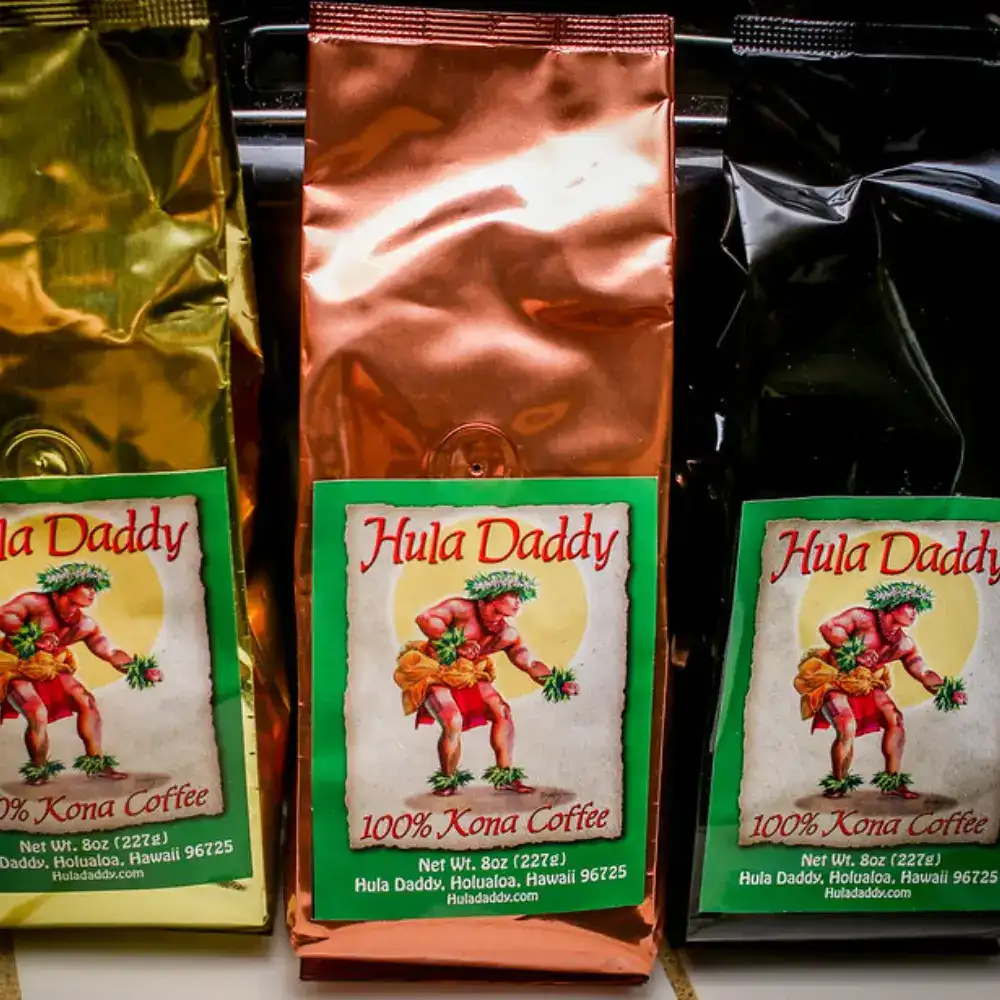
Known for its high-quality products and dedication to sustainability, Hula Daddy Kona Coffee is a standout coffee brand. Their careful bean selection and small-batch roasting technique ensure a fresh and flavorful coffee experience. Like Koa Coffee, Hula Daddy also has the honor of being named “Best Coffee in America” by Forbes.
The Dance of Flavor with Hula Daddy
Hula Daddy Coffee, grown and roasted in the Kona region of Hawaii, is a premium brand celebrated for its world-class coffee. They use top-tier beans and an artisanal roasting process to produce a unique flavor profile characterized by smoothness, richness, and subtle sweetness.
Key Features:
- Grown and roasted in the Kona region of Hawaii
- High-quality beans with a unique flavor profile
- Careful hand-picking and precise roasting process
- Vacuum-sealed packaging for maximum freshness
Pros:
- Smooth, rich flavor with a unique taste
- High-quality beans and roasting process
- Ethically sourced beans
- Vacuum-sealed packaging to maintain freshness
Cons:
- Premium price compared to other brands
- Limited availability in certain areas
Guru’s Verdict: While Hula Daddy Kona Coffee sits at a higher price point, the exceptional quality of the beans and the precision in the roasting process make it worth every penny. If you’re seeking a unique coffee experience, this premium brand is worth a taste. For more information, check out our website here
Kona Coffee and Tea Company: A Sustainable Family Business
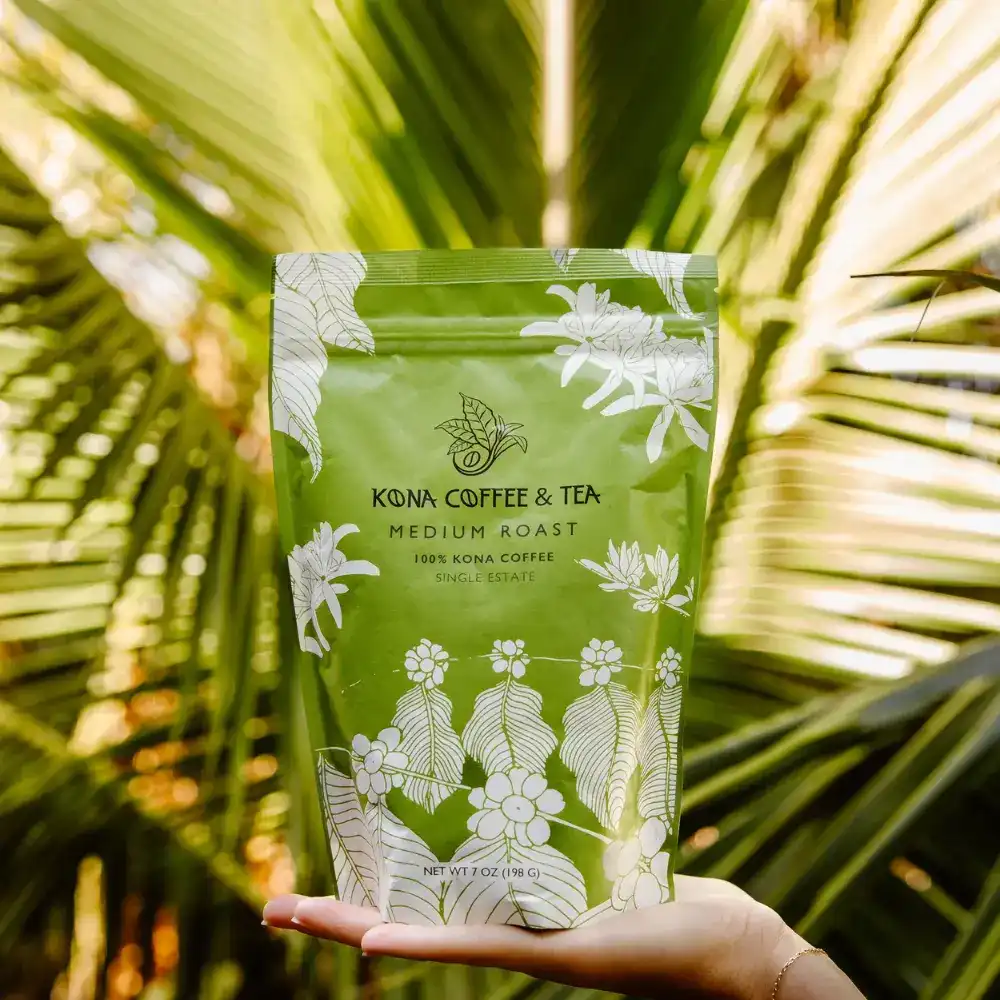
With over two decades in the business, the family-owned Kona Coffee and Tea Company is another prominent producer of 100% Kona coffee. Grown on the slopes of Hualalai, their coffee is a testament to their commitment to sustainability and organic farming practices.
| Preview | Product | |
|---|---|---|

| Light Roast (1) – 100% Kona Coffee | See on Amazon |

| Medium Roast (1) – 100% Kona Coffee | See on Amazon |
The Kona Blend of Tradition and Sustainability
Kona Coffee and Tea Company, based in the Kona region of Hawaii, offers a variety of locally grown, harvested, and roasted coffee and tea blends. Their commitment to sustainability and eco-friendly practices extends to their 100% compostable packaging and support for local farmers.
Key Features:
- Locally grown and roasted specialty coffee and tea blends
- Emphasis on sustainability and eco-friendly practices
- 100% compostable packaging
- Support for local farmers
Pros:
- Unique flavor profile in high-quality coffee and tea blends
- Practices appeal to environmentally conscious consumers
- Support for local farmers benefits the local economy
- Compostable packaging reduces environmental waste
Cons:
- May be pricier than other coffee and tea brands due to its specialty nature and local production
- Limited availability outside of Hawaii
Guru’s Verdict: For consumers seeking sustainable, locally sourced products, Kona Coffee and Tea Company offers a unique and high-quality option. While their specialty products might come with a higher price tag, their commitment to eco-friendly practices and local farmer support justifies the investment. However, note that availability may be limited outside Hawaii.
Greenwell Farms: A Legacy of Quality
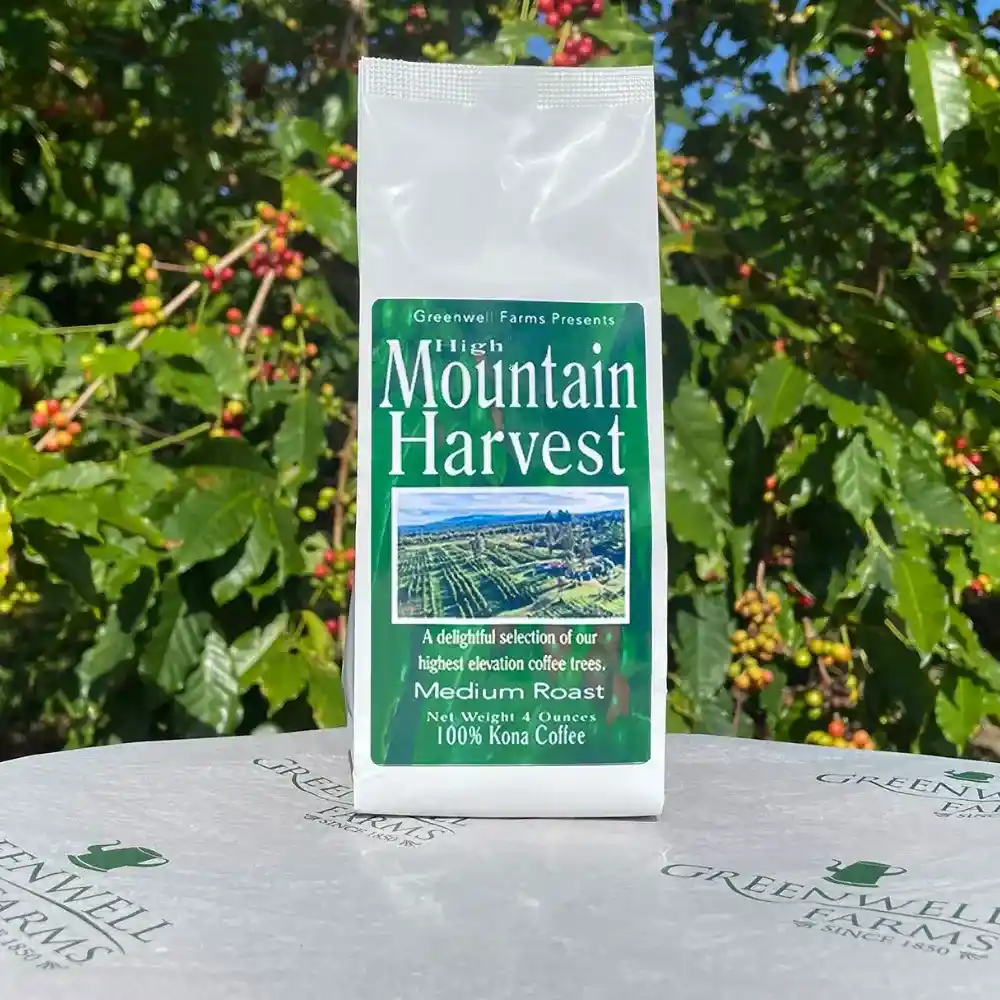
As one of the oldest coffee brands dating back to the 1850s, Greenwell Farms offers 100% Kona coffee, grown on the slopes of the Hualalai volcano. Their commitment to sustainable farming practices has earned them recognition, including winning the award of the State’s Top Coffee honor.
A Taste of History with Greenwell Farms
Greenwell Farms is a coffee farm and roaster situated in the heart of the Kona coffee region on Hawaii’s Big Island. Founded in 1850 by Henry Nicholas Greenwell, the company has been producing high-quality coffee for over a century and a half.
Key Features:
- Premium Kona beans are grown on the slopes of Hualalai volcano
- Single-origin coffee with a smooth, rich flavor and low acidity
- Small-batch roasting for maximum freshness and flavor
Pros:
- Unique flavor profile in high-quality coffee
- Sustainable farming practices and environmental stewardship
- Direct-to-consumer sales model ensuring fair pricing
- Rich history and tradition dating back over 150 years
Cons:
- Higher price point relative to other coffee brands
- Limited availability due to small-scale production
Guru’s Verdict: Greenwell Farms is an excellent choice for coffee aficionados who value high-quality, unique coffee experiences. Their commitment to sustainable farming and fair pricing makes them a socially responsible choice. Despite a higher price point and limited availability due to small-scale production, the quality of the product and the company’s rich history makes it a worthwhile investment for a truly exceptional cup of coffee.
Volcanica Coffee: The Epitome of Luxury and Taste
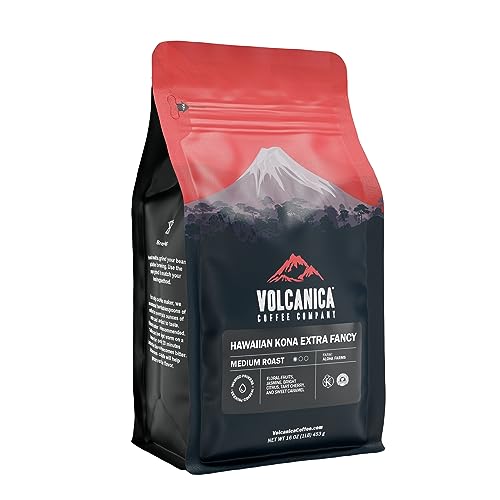
Volcanica Coffee’s Hawaiian Extra Fancy Kona Coffee provides a supreme sensory experience with its rich, well-defined flavors. Revel in the smooth consistency and a unique blend of tastes, encompassing the floral undertones of jasmine, invigorating hints of citrus, tangy cherries, and the tantalizing sweetness of caramel. This Kona coffee variety holds the highest classification—Extra Fancy—signifying its unmatched purity and exclusive availability. If you’re interested in trying this coffee out, you can claim 10% off below.
- Authentic Hawaiian Kona Extra Fancy Coffee with a refined taste, smooth body, superb aroma and a buttery richness with nutty cinnamon and clove overtones.
- 100% authentic Kona X-Fancy Coffee and Single Origin. This is NOT a Kona Blend that usually contain little to none Kona Coffee.
- Certified by the State of Hawaii.
- Medium roasted ground coffee allowing the true flavor characteristic to come through for a remarkable taste. Fresh roasted then immediately packed and sealed to assure freshness.
- Fresh roasted then immediately packed and sealed to assure freshness.
Key Features:
- Highest grade Kona coffee—Extra Fancy.
- Floral fruits, jasmine, bright citrus, tart cherry, and sweet caramel flavors.
- Single-origin beans for guaranteed consistency and traceability.
- Washed process and medium roast for enhanced richness.
- Kosher Certified and State of Hawaii Certified.
- Shade-grown beans, contributing to unique taste and quality.
- Low acidity level (pH 5.2) compared to most other coffees.
- For 16 oz bag purchases, a premium Blue Velvet Bag is included.
Pros:
- Exquisite blend of unique flavors offers an exceptional taste experience.
- High-quality, shade-grown beans ensure distinctive attributes.
- The single-origin sourcing guarantees consistency and traceability.
- Lower acidity level makes it a good option for those sensitive to acidic coffees.
- High-grade certification assures premium quality and purity.
Cons:
- Exclusive availability might make it hard to find.
- High-grade classification could make it more expensive than other brands.
- Blue Velvet Bag is not included in the 5 lb bag unless specifically requested.
Guru’s Verdict: Volcanica Coffee’s Hawaiian Extra Fancy Kona Coffee is truly a connoisseur’s delight. With its impressive array of flavors and premium quality, this coffee offers an unmatched coffee drinking experience. Its unique cultivation process and traceability further add to its appeal, despite its limited availability and a potentially higher price point.
Sustainable Practices in Kona Coffee Production
Kona coffee, a jewel of Hawaiian agriculture, is renowned for its smooth flavor and rich aroma. However, producing this coffee isn’t just about crafting the perfect cup; it’s also about embracing sustainable practices that protect the environment and ensure fair treatment for workers. Kona Mountain Coffee and other farms are leading the way in these efforts.
The Role of Organic Farming
Organic farming plays a crucial role in sustainable coffee production. Hawaiian Kona coffee farms, like Kona Mountain Coffee, have embraced organic farming practices to minimize their environmental impact.
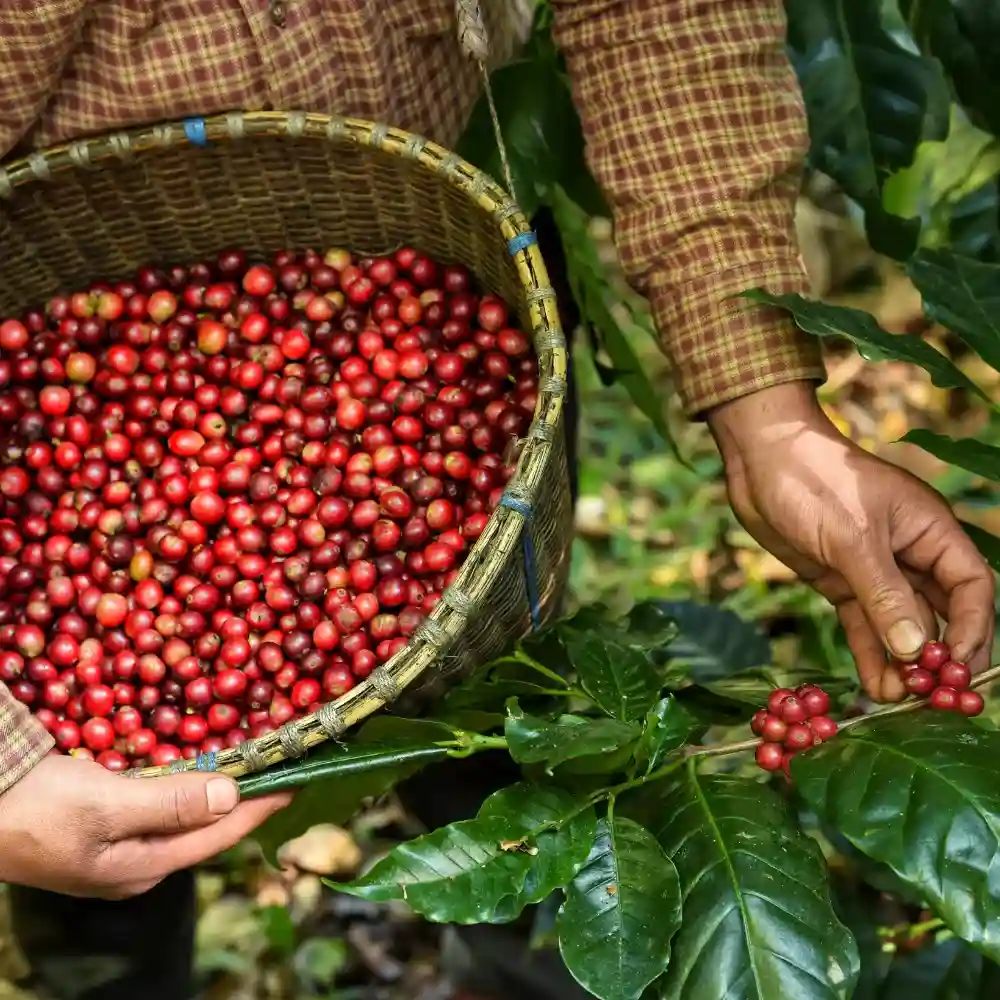
These practices include using organic fertilizers, avoiding synthetic pesticides, and implementing natural pest management strategies. Organic farming also improves soil health, promotes biodiversity, and helps to maintain the beautiful natural landscape of the Kona region.
The result of these sustainable efforts is a cleaner, healthier environment, and a high-quality coffee bean that is produced without the use of harmful chemicals.
Fair Trade in Kona Coffee
Fair Trade practices are also an integral part of sustainable coffee production. The Fair Trade model ensures that farmers and workers receive fair wages and work in safe conditions. It also promotes direct trade relationships, which can lead to more stable prices for farmers and a closer connection between consumers and the people who grow their coffee.
Kona coffee farms are embracing Fair Trade practices to ensure that every individual involved in the coffee production process, from the farmers to the workers on the Kona coffee tours, is treated fairly and with respect. This approach not only helps to improve the lives of the workers but also enhances the overall quality of the coffee.
The Future of Kona Coffee Production
The future of this coffee production lies in the continued adoption and advancement of these sustainable practices. By further embracing organic farming and Fair Trade practices, Kona coffee farms can continue to produce high-quality coffee while also protecting the environment and ensuring fair treatment for workers.
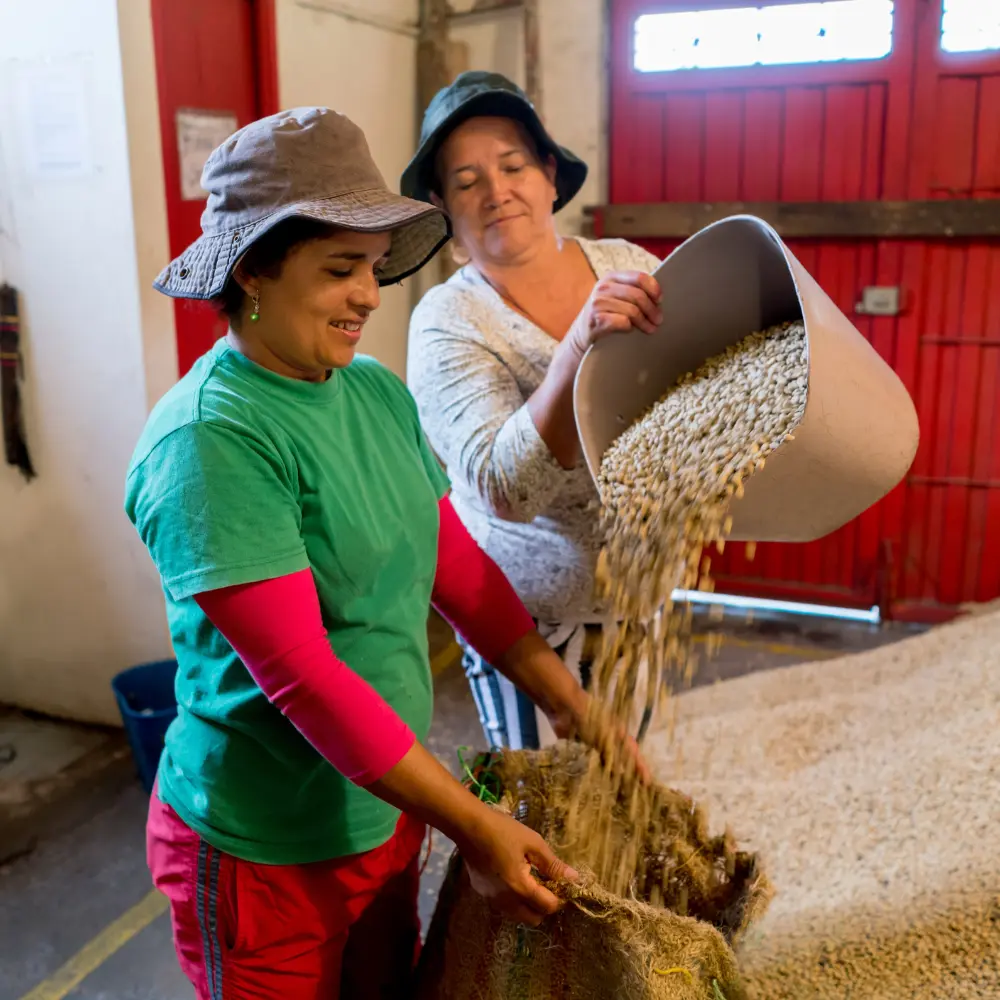
Innovative practices such as agroforestry, where coffee is grown under a canopy of native trees, can also play a part in the future of this coffee production. This method can help to increase biodiversity, improve soil health, and sequester carbon, making it a win-win for both the coffee and the environment.
Kona coffee tours are also an essential part of the future of the industry. As discussed earlier, these tours not only provide a unique experience for visitors but also educate them about the sustainable practices used in the production of this coffee. The more that consumers understand and appreciate these practices, the more demand there will be for sustainably produced coffee.
To sum up, the future of this coffee production is looking bright, thanks to the sustainable practices being embraced by Kona coffee farms. By continuing to focus on organic farming, Fair Trade, and innovative agricultural practices, these farms can ensure that they continue to produce high-quality, sustainable Hawaiian Kona coffee for generations to come.
Conclusion
In conclusion, the unique world of this delectable beverage, from ground to cup, is truly an experience worth exploring. From understanding what is Kona Coffee, to appreciating the meticulous farming practices and optimal Hawaiian conditions that contribute to its production, and ultimately savoring its distinctive, rich taste, this journey is a testament to the allure of this world-renowned beverage. Whether you’re a seasoned coffee aficionado or a newcomer to the scene, the exploration of the best Kona Coffee varieties will undoubtedly lead you to a deeper appreciation of this exquisite drink. So, here’s to Kona Coffee – a coffee not just to be consumed, but to be experienced.
FAQ
How does the climate of Hawaii influence the taste of Kona Coffee?
Hawaii's tropical climate, coupled with rich volcanic soil and the specific combination of sunlight, rainfall, and temperature in the Kona region, contributes to the unique, full-bodied flavor of this beverage.
What is the best way to brew Kona Coffee to retain its unique flavor?
The best way to brew this coffee is by using a drip coffee maker, French press, or a pour-over method, all of which allow the unique flavors to fully develop without being overshadowed by bitterness.
How does sustainable farming impact the quality of Kona Coffee?
Sustainable farming enhances this coffee's quality by maintaining the health of the soil and environment, leading to coffee beans that are grown without the use of harmful chemicals, thereby preserving their natural taste and quality.
What are the different varieties of Kona Coffee and how do they differ in taste?
This coffee comes in different varieties like Kona Extra Fancy, Kona Fancy, Kona Number 1, Kona Select, and Kona Prime, each varying in taste, body, and acidity based on the size and grade of the bean, with Kona Extra Fancy being the highest quality and most flavorful.
